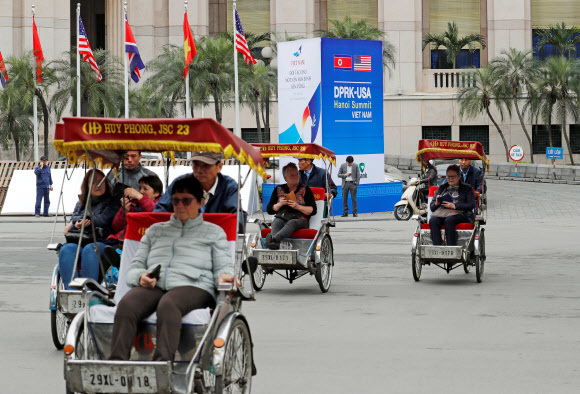 |
|
A busy street in Hanoi, Vietnam. (EPA)
|
KIEP report reveals scale of Vietnam’s economic progress since establishing relations with US
Vietnam, the host country for the second North Korea-US summit, has achieved growth levels ranging from five to 450 times in various economic indicators including growth, investment, imports and expertise over the 23 to 38 years since the 1980s to 1990s through a combination of internal reform and openness measures and a process of the US lifting its economic sanctions. Analysts suggested a similar progress to that sanctions removal – which stretched out over more than two decades – could also apply in the case of lifting US economic sanctions against North Korea. A report titled “Removal of Economic Sanctions in Response to North Korean Denuclearization” published on Feb. 25 by the Korea Institute for International Economic Policy (KIEP) noted that Vietnam achieved an annual economic growth rate of 6.4% over the 28-year period from 1980 to 2017 amid the three phases of its Doi Moi economic reform policies since 1986 and the normalization of relations with the US and other Western nations. Its nominal GDP rose nearly eightfold from US$27.84 billion in 1980 to US$220.4 billion in 2017, while per capita nominal GDP quintupled from US$514 to US$2,354 over the same period. “Examination of Vietnamese GDP trends over the past 20 to 30 years shows it to have achieved economic growth amid improvements in its external relations with the US,” the report said. “After laying a foundation for economic growth during the 1990s, internally with Doi Moi and externally with its withdrawal from Cambodia, [Vietnam] went on to establish diplomatic relations with the US in 1995 (with a trade embargo lifted in 1994), sign a trade agreement with the US in 2001, acquire the foreign direct investment (FDI) and official development assistance (ODA) necessary for economic growth through WTO membership in 2006, and achieve rapid growth in imports and exports,” it noted. The report also analyzed influences on changes in Vietnamese economic indicators amid progress in normalizing relations with the US. The amount of FDI entering Vietnam rose sharply with its 2001 signing of a trade agreement with the US and 2006 membership in the WTO. As the trade agreement led to Vietnam rapidly emerging an indirect export base for the US, FDI rose from US$120 million in 1990 to US$15.8 billion in 2016 – a difference of 132 times. Cumulative FDI inflows over this period totaled US$154.6 billion. ODA also began a trend of major increase with the 1991 signing of a peace agreement with Cambodia, permission from the Clinton administration for international financial institutions to resume support in 1993, and the 1995 establishment of diplomatic relations with the US. Totaling US$230 million in 1991, ODA rose to US$570 million the following year after the peace agreement was signed. By 2000, it had reached US$1.68 billion; as of 2016, it totaled US$2.889 billion – a roughly 23-fold increase.
 |
|
Tourists riding rickshaws in front of the Sofitel Legend Metropole Hanoi hotel on Feb. 25, two days before the second North Korea-US summit. (Yonhap News)
|







